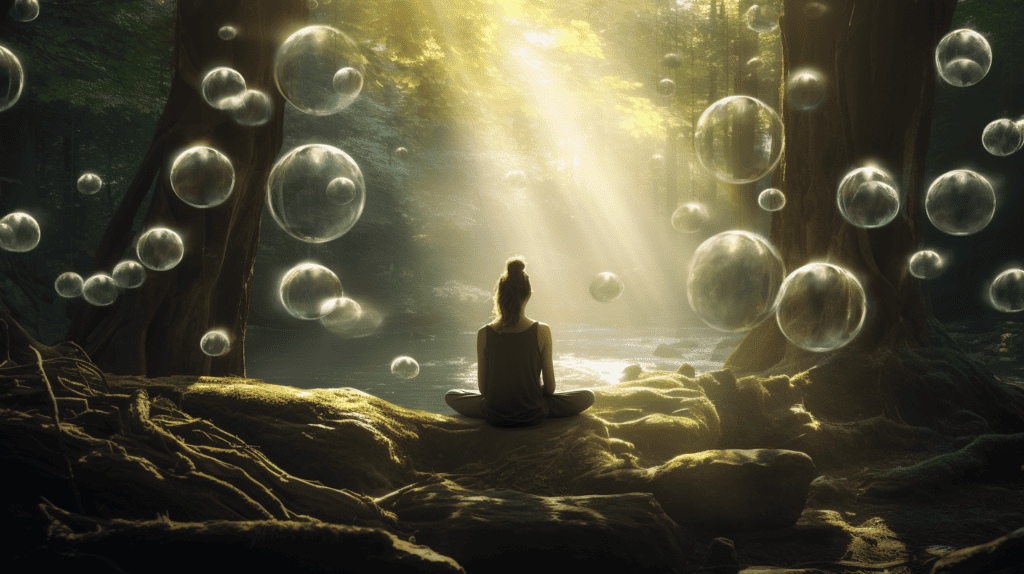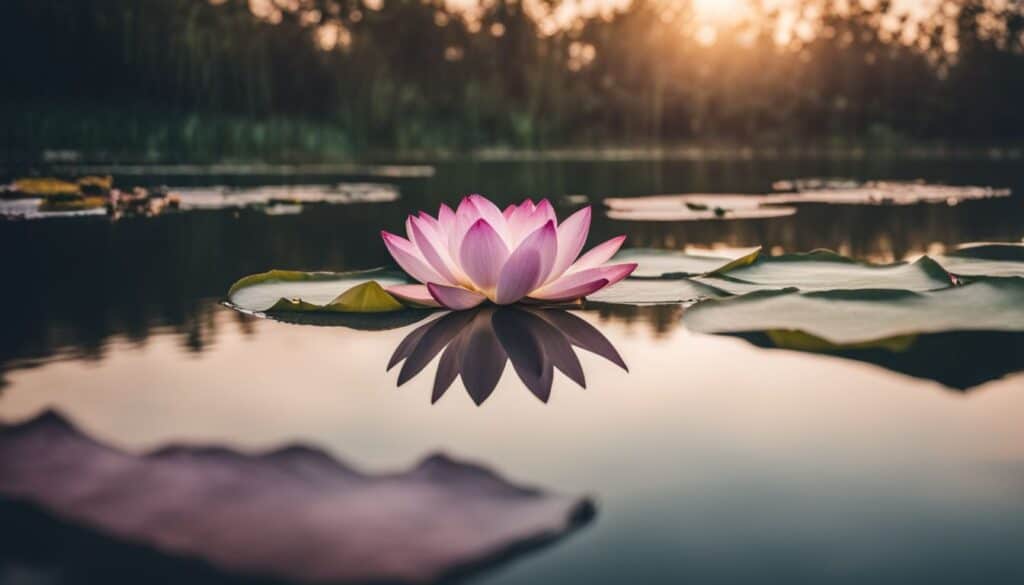This spiritual dimension isn’t about religious beliefs or intellectual concepts but about exploring within ourselves to discover inherent peace and tranquility.
This beginner’s guide will gently introduce the timeless art of meditation, offering step-by-step guidance on how to weave this serene thread into the fabric of your spiritual life.
Key Takeaways
- Access a spiritual dimension within ourselves through meditation to find peace and tranquility.
- The spiritual dimension is always present but often overlooked in our busy lives, and meditation helps us cultivate an awareness of it.
- Meditation is not just about finding stillness in quiet settings; it’s about carrying that sense of stillness into our daily lives and living with mindfulness and presence.
- Overcoming the mind’s resistance to meditation requires patience and persistence, but with practice, we can tap into a more profound sense of peace within ourselves.
- The spiritual dimension is like water for a fish – constantly there but often unnoticed. By becoming aware of this more profound realm within us, we can experience greater fulfillment.
- Different traditions use terms to describe the spiritual dimension, such as “nirvana” or “enlightenment,” but all point towards the same underlying truth – a more profound reality beyond our everyday experiences.
Understanding the Spiritual Dimension through Meditation
Accessing the spiritual dimension within ourselves through meditation is a profound journey of self-discovery and awakening. It allows us to tap into a level of consciousness beyond our ordinary perception, where we can connect with our higher self and experience a more profound sense of peace and clarity.
“Every time you sit down to practice, you’ve succeeded.” – Mindfulness.com
This spiritual dimension is not separate from us; it is always present but often overlooked in the busyness of daily life. Through meditation, we can cultivate an awareness of this dimension and integrate it into our everyday existence, allowing us to live with greater presence and authenticity.
Meditation Practice that Follows Eckart Tolle’s Teachings
Begin by finding a quiet space where you won’t be disturbed. Sit comfortably with your back straight, either on a cushion on the floor with your legs crossed or in a chair with your feet flat on the ground. Close your eyes or lower your gaze to a point on the floor before you.
Take a deep breath through your nose, feeling your abdomen expand, and then exhale slowly through your mouth or nose, feeling your body naturally relax. Place one hand on your stomach to feel the rise and fall with each breath. Do this briefly to center yourself and become present in the now.
Once you feel centered, visualize a warm, radiant light above your head—golden and soft. With each inhale, imagine this light descending through the crown of your head, filling your body with warmth and peace. With each exhale, imagine any tension or negativity being expelled from your body, leaving with your breath.
Continue this visualization for several minutes, allowing the light to grow brighter and your body to feel lighter with each breath cycle. If your mind begins to wander, gently acknowledge the thought and then refocus on the light and your breathing, allowing yourself to sink deeper into calm and peace with each passing moment.
Perspective on accessing the spiritual dimension within oneself through meditation
We all have a part of us that we can’t see or touch, but it’s there. Eckhart Tolle calls this the spiritual dimension. This part is deep inside you and quiet as a whisper. He says we can reach it through meditation.
Imagine taking your mind on a dive into still waters — that’s what meditating does! You sit still, calm your thoughts, and let yourself sink into the silence within you. The deeper you go, the more peace you find.
This journey to the inner self helps us tap into our spiritual side. It isn’t about following any rules or beliefs. It’s about discovering who we are, below all our thoughts and feelings—the place where true peace lives!
The concept of the spiritual dimension
You may wonder, what is this “spiritual dimension“? It’s simple. The spiritual dimension is a place of calm and peace inside you. You can get to it through meditation. This space lives deep inside all of us.
But many of us don’t know about it.
Living with an awareness of this realm changes your life. Once you tap into it, daily stress doesn’t bother you as much. Hard times become more accessible to handle. Life becomes fuller and richer because you are no longer living in your mind.
Recognizing the importance of living with awareness of this dimension

Being aware of the spiritual part inside us is a big deal. Every day, we should try to feel it. This helps us lead a mindful life. It’s like finding our map for life. With this, we can find ways to stay calm in tough times.
We can also have better control over feelings and thoughts. We realize that we are more than just our bodies or minds. A deep connection with self gives rise to inner peace and clarity of mind, benefits of meditation practice!
The Two Aspects of the Spiritual Journey through Meditation
In my experience as a spiritual meditation teacher, I have come to understand that the journey towards accessing the spiritual dimension through meditation has two distinct aspects.
The first aspect involves accessing this dimension in quiet and peaceful settings. This can be achieved by creating a serene environment where one can relax and let go of external distractions.
During these moments of stillness, individuals can tap into their inner selves and connect with the deeper dimensions of consciousness. In these moments, they may experience profound insights, clarity, and a sense of oneness with the universe.
“Guided meditations are an excellent tool for beginners, as they provide a focal point and gentle instruction to help you connect and let go of self-judgment.” – Mindful
However, it is equally important for individuals to carry this sense of stillness into their daily lives. Meditation shouldn’t just be confined to specific sessions or moments; it should become an integral part of our existence.
This means cultivating mindfulness and awareness throughout our day-to-day activities.
By doing so, we shift from merely seeking fleeting moments of peace during meditation to embodying a state of presence at all times. We learn.
Finding access to the spiritual dimension in quiet settings

To access the spiritual dimension, you can find quiet settings for meditation. It’s about sitting in stillness and connecting with the emptiness within yourself.
The goal is to live with an awareness of this spiritual dimension in your daily life, not just during your meditation practice.
Carrying the sense of stillness into daily life in Meditation
In meditation, it’s not just about finding stillness in quiet settings. It’s also essential to carry that sense of stillness into your daily life. This means being aware and present in each moment, even during everyday activities and interactions.
Living with an understanding of the spiritual dimension and cultivating a sense of inner peace throughout the day is significant. So, whether you’re washing dishes or having a conversation, try to maintain that state of calm, and awareness within yourself.
Remember, the spiritual dimension is always present but often overlooked. By bringing stillness into your daily life, you can tap into this more profound aspect of yourself and experience greater peace and fulfillment.
Overcoming the Mind’s Resistance While Meditating
When it comes to meditation, one of the biggest challenges is overcoming the mind’s resistance. The mind is always active, constantly chattering and generating thoughts that pull us away from stillness and presence.
But practice teaches us to quiet the mind and find a deeper sense of peace. It requires patience and persistence to overcome this resistance, but with time, we can cultivate a greater awareness and connection with our spiritual dimension.
The challenge of understanding the concept of the spiritual dimension
Understanding the concept of the spiritual dimension can be a challenge. Our minds often resist grasping this idea because it’s not something we can easily explain or analyze intellectually.
It’s important to remember that the spiritual dimension is not just about concepts and words; it goes beyond that. To truly understand it, we must go deeper and tap into our stillness and inner awareness.
By tuning in to the quiet space within ourselves, we can experience a non-verbal understanding of the spiritual dimension that transcends intellectual limitations and opens us up to a whole new level of insight and realization.
Seeking a non-verbal understanding through stillness

As we dive deeper into the concept of the spiritual dimension, our mind may resist understanding it. However, a non-verbal understanding can be reached by simply noticing the stillness behind and within his words.
“The easiest way to begin meditating is by focusing on the breath, which is one of the most common approaches to meditation.” – Gaiam
This means that instead of trying to grasp the idea with our thoughts, we can tap into a deeper level of understanding through silence and stillness. By quieting our minds and allowing ourselves to be present in the moment, we can access this non-verbal understanding and connect with the spaciousness of our inner being.
It’s not about finding answers or analyzing concepts; it’s about experiencing and embodying the essence of this spiritual dimension through a state of deep presence and awareness.
The Paradox of Unawareness
Amid our daily lives, we often overlook the spiritual dimension that is always present. It’s like a fish swimming in water, unaware of its surroundings. We become so caught up in our thoughts, emotions, and external distractions that we forget to tap into the more profound realm within ourselves.
But this spiritual dimension is not something separate from us or inaccessible; it is always there, patiently waiting for us to recognize it. Through meditation, we can break through the illusion of unawareness and start experiencing the true essence of who we are.
During meditation, as we sit in stillness and silence, we create a space for awareness to arise. We let go of all attachments to thoughts and sensations and observe what arises without judgment or resistance.
In doing so, we open ourselves to accessing the spiritual dimension.
It may be challenging to understand this concept intellectually because it cannot be fully grasped with words alone. Instead, it requires a direct experience through stillness and presence.
The spiritual dimension always being present yet often overlooked
Different traditions use different words to describe this dimension, like “emptiness” or “spaciousness.” we can consider it a “dimension” similar to “spaciousness.” We often overlook this inner dimension because we get distracted by our senses and thoughts.
But if we pay attention and quiet our minds, we can become aware of the spiritual dimension that is always there.
Comparing it to a fish not realizing it is in water
Sometimes, we are like fish swimming in water without even realizing it. Just as a fish is so immersed in the water that it doesn’t recognize its presence, we often overlook the spiritual dimension that is always present within us.
This spiritual dimension goes unnoticed because we are so caught up in our everyday lives and distractions. But just like the fish needs water to live, our spiritual dimension is essential for our well-being and understanding of ourselves.
It’s time to become aware of this deeper dimension and embrace its presence in our lives.
Different Terms for the Spiritual Dimension

Throughout history, various spiritual traditions and teachers have used different terms to describe the concept of the spiritual dimension. Buddha referred to it as “nirvana” or “enlightenment,” while Jesus spoke about the “kingdom of God” or “heaven.” These terms may differ in language, but they all point towards the same underlying truth – a deeper reality beyond our everyday experiences.
It’s important to understand that these terms are not meant to be mere intellectual concepts but rather invitations for us to explore and experience this dimension within ourselves through meditation.
By aligning with this inner spaciousness, we can bypass belief systems and connect with the stillness already present within us.
Buddha
Buddha, a spiritual teacher, used different terms to describe the spiritual dimension. He referred to it as “emptiness” or “spaciousness.” His teachings are part of various spiritual traditions and provide insights into the nature of this dimension.
Buddha’s concept of the spiritual dimension aligns with the idea of “spaciousness.” It can be compared to the concept of “heaven” in Christianity. Understanding Buddha’s teachings can help deepen our understanding of the spiritual dimension and its significance.
Jesus
Jesus referred to the spiritual dimension as the “kingdom of heaven.” He used different terms to describe this dimension, emphasizing its importance. Jesus understood that there is a deeper reality beyond our physical existence.
By exploring and connecting with this spiritual dimension, we can find inner peace and a greater sense of purpose in life.
Aligning with the Inner Spaciousness
Aligning with the inner spaciousness is crucial to accessing the spiritual dimension within oneself. It is essential to recognize that the spiritual dimension is not about belief systems or external rituals but rather about connecting with the stillness and presence within us.
In meditation, we can intentionally shift our focus from distractions of sensory perceptions and thought activity to this more profound dimension. By aligning ourselves with the inner spaciousness, we can experience peace, clarity, and connection to something greater than ourselves.
This alignment allows us to navigate life’s challenges with more ease and grace, as we are rooted in a deep awareness of our true self as aware presence. Regular practice allows us to cultivate a deeper understanding of our spiritual nature and integrate meditation into our daily lives for continued growth and transformation.
Recognizing the spiritual dimension is not about belief systems
I believe recognizing the spiritual dimension is not about adhering to a particular belief system. It goes beyond religious dogma or specific doctrines. Instead, it’s about connecting with something deeper within ourselves, something that transcends our earthly experiences and limited perceptions.
The spiritual dimension is about tapping into the spacious stillness within us, regardless of our beliefs or lack thereof. It’s about aligning with this inner stillness and recognizing its presence in our lives.
This recognition requires a shift in perspective, a non-verbal understanding that goes beyond words and concepts. It invites us to explore the depths of our consciousness and connect with something greater than ourselves – a realm of deep inner peace and wisdom.
Aligning with the stillness already present within oneself

Aligning with the stillness within ourselves is a powerful practice that can be accessed through meditation. It is a realm of deep inner stillness where we connect to our true selves and experience peace and clarity.
By tapping into this inner dimension, we can navigate life with awareness and presence rather than being solely guided by our busy minds. This requires finding moments of quiet and solitude where we can access this stillness and carry that sense of calm into our daily lives.
However, by intentionally shifting our focus to the deeper dimension within us, we can tap into the infinite wellspring of peace.
Overlooking the Inner Dimension
Many overlook the inner dimension, the spiritual aspect of our being. We often get caught up in distractions from sensory perceptions and the constant activity of our thoughts.
It’s crucial to shift our focus to this deeper dimension within us. Doing so allows us to tap into a sense of stillness and connect with something greater than ourselves. This requires a conscious effort to detach from the external world and tune into our inner awareness.
Through meditation, we can quiet the mind and allow ourselves to experience the depths of our being beyond superficial forms and identities.
Distractions of sensory perceptions and thought activity
Sometimes, we get so caught up in our thoughts and what we see and hear around us that we forget to connect with a deeper part of ourselves. We become distracted by the sensory perceptions – like seeing, hearing, and feeling – and the constant activity in our minds.
These distractions prevent us from recognizing and aligning with the stillness within us.
When constantly pulled in different directions by our senses and thoughts, it can be challenging to focus on the present moment. We may miss out on experiencing a sense of inner peace and connection to something greater than ourselves.
By letting go of these distractions and shifting our focus to the deeper dimension within us, we can find a sense of calm and gain a deeper understanding of ourselves. It’s important not to let these distractions define who we are or dictate how we respond to life’s events.
Instead, we can avoid getting drawn into unnecessary drama or frustration by cultivating awareness of our stillness.
The importance of shifting focus to the deeper dimension
I want to emphasize the importance of shifting our focus to the deeper dimension within ourselves. In our busy lives, we often get caught up in our thoughts, emotions, and sensory experiences without realizing that there is another level of existence beneath it all.
This deeper dimension is where true peace, stillness, and awareness reside. By shifting our focus to this more profound dimension, we can tap into a sense of spaciousness and connectedness that brings profound spiritual benefits.
It allows us to go beyond the surface level of life and experience a greater understanding of ourselves and the world around us. So, let’s take a moment to shift our attention inward and explore this deeper dimension within ourselves.
Meditative Self-Reflective Exercise
During this meditative self-reflective exercise, we will bring awareness to our thoughts, feelings, and sense perceptions. Take a moment to find a comfortable position and close your eyes.
Begin by focusing on your breath, allowing it to flow in and out naturally. As you continue to breathe deeply, notice any thoughts that arise without judgment or attachment. Observe them as they come and go, like passing clouds in the sky.
Next, shift your attention to any emotions or feelings that may be present within you. Notice how they manifest in your body – perhaps as sensations of warmth or tension. Allow yourself to fully experience these emotions without resistance or the need for explanation.
Finally, turn your awareness towards your sense perceptions – what you hear, see, smell, touch, and taste. Tune into each sensation individually and explore its qualities without labeling or analyzing them.
As you engage in this self-reflective exercise, remember that the goal is not to change or manipulate your experiences but
Noticing thoughts, feelings, and sense perceptions through meditation
During meditation, paying attention to our thoughts, feelings, and the sensations we experience is important. By doing this, we become aware of these aspects of ourselves deeper.
This awareness belongs to the spiritual dimension within us. It helps us understand that our life is like a canvas where thoughts, emotions, and sensory experiences are drawn. We can also think of ourselves as the projector of light on a cinema screen where all experiences unfold.
This detached awareness changes how we relate to our experiences and allows us to see them differently.
Recognizing the awareness that observes these experiences
As we engage in meditation, it becomes essential to recognize the awareness that observes our thoughts, feelings, and sense perceptions. Self-reflective exercise is where we take notice of these experiences and become aware that they belong to a deeper spiritual dimension within ourselves.
This awareness is like a light shining on the canvas of our lives, revealing the true essence of who we are. Recognizing this inner awareness can deepen our understanding and connection to our spiritual dimension.
The Canvas Analogy
In meditation, Eckhart Tolle often uses the analogy of life as drawings on a canvas to help individuals understand their spiritual dimension. He encourages people to identify with the underlying awareness, like the canvas itself, rather than getting caught up in temporary forms and experiences.
This shift in perspective allows us to recognize our authentic selves as aware presence, separate from and yet connected to the ever-changing scenes playing out on the canvas of life. By detaching ourselves from identification with these forms, we can cultivate a more profound sense of inner peace and connection with something greater than ourselves.
Life as drawings on a canvas, with consciousness as the underlying reality
Life can be compared to drawings on a canvas, where our thoughts, emotions, and sensory experiences are depicted. However, the true essence of life lies in the underlying consciousness or awareness that exists beyond these temporary forms.
This consciousness is our true self, not the transient nature of our thoughts and experiences. Eckhart Tolle introduces another analogy – that of a cinema screen. In this analogy, we are like the projector of light (consciousness) while life’s experiences are enacted on the screen.
Recognizing ourselves as the projector allows us to have detached awareness and transform our relationship with life’s events. It is essential to understand this concept to avoid getting caught up in the drama and frustrations that come with not recognizing consciousness as the underlying reality.
Identifying with the underlying awareness rather than temporary forms
As I delve deeper into my spiritual journey through meditation, I realize the importance of identifying with the underlying awareness rather than getting caught up in temporary forms.
It’s like recognizing that my life is a beautiful painting drawn on a canvas and that canvas represents my true self – consciousness or awareness. Instead of getting lost in the thoughts, emotions, and experiences that come and go, I shift my focus to the unchanging presence within me.
By understanding myself as the light of consciousness, I can cultivate a sense of detached awareness and navigate through life’s events without being consumed. This shift in perspective has brought about a profound sense of peace and clarity in my spiritual practice.
The Cinema Screen Analogy
In this analogy, Tolle compares our life experiences to a movie projected onto a cinema screen. He suggests that consciousness is like the projector, and our experiences are like the images on the screen.
By recognizing ourselves as the light of consciousness rather than getting caught up in the drama of life’s events, we can maintain a detached awareness and seek solutions through meditation.
This analogy encourages us to shift our perspective from identifying with temporary forms to aligning with the underlying presence of awareness.
Experiences enacted on a screen, with consciousness as the projector
In meditation, I have realized that my experiences are like scenes being acted out on a screen. And what is projecting those scenes? It’s consciousness itself, the source of light.
I can observe these experiences with a sense of detachment when I understand myself as the projector. This change in perspective alters how I relate to the drama unfolding on the screen.
Instead of getting caught up in it and seeking solutions, I can maintain a state of awareness and inner stillness. This understanding is essential for deeper spiritual growth and realizing my true self as an aware presence.
Recognizing oneself as the light of consciousness
I am the light of consciousness, the projector of my experiences. Like a cinema screen, all my experiences are enacted on this screen of awareness. By realizing this truth, I can cultivate detached awareness and observe life’s events without getting caught up in the drama.
Recognizing myself as the “light of consciousness” is a fundamental prerequisite for understanding my spiritual dimension on a deeper level. It allows me to shift my focus from temporary forms to the underlying reality of awareness that is always present within me.
Through meditation, I can align with this inner spaciousness and live with greater presence and clarity in each moment.
Detached Awareness While Meditating
When practicing meditation, it is vital to cultivate a sense of detached awareness. This means changing how you relate to life’s events during meditation. Instead of getting drawn into the drama and seeking solutions through meditation, focus on observing and accepting what arises without judgment or attachment.
Detached awareness allows you to experience the present moment fully and helps you maintain a sense of calm and clarity in the face of any challenges that may arise.
Changing the way one relates to life’s events during meditation
During meditation, I have discovered the power of changing how I relate to life’s events. Instead of getting caught up in the drama and seeking solutions, I have learned to cultivate detached awareness.
This means observing life’s events without getting emotionally entangled or trying to control them. I have found greater peace and contentment in accepting things by shifting my perspective.
Meditation has helped me realize that true happiness comes from within rather than relying on external circumstances for fulfillment. Through this practice, I have learned to navigate life with a calmer mind and a more open heart.
Avoiding getting drawn into the drama and seeking solutions through meditation
To truly benefit from meditation, it’s crucial to avoid getting caught up in the drama of life. Instead, seek solutions and happiness within yourself through meditation. Eckhart Tolle emphasizes the importance of recognizing the “spaciousness” within oneself.
Becoming a detached observer can change how you relate to life’s events. This allows you to avoid getting drawn into unnecessary drama and find solutions with a clear mind.
Meditation helps you shift your focus inward and cultivate inner peace, enabling you to navigate life’s challenges calmly and clearly. So, to find lasting solutions and avoid being overwhelmed by drama, turn to meditation as a powerful tool for self-discovery and transformation.
The True Self as Aware Presence
The concept of the true self as aware presence is crucial for understanding one’s spiritual dimension. It involves sensing the fundamental awareness that exists at any moment beyond thoughts and emotions.
This awareness serves as a prerequisite for more profound spiritual growth and enlightenment. Recognizing oneself as this aware presence can cultivate a sense of inner peace and connection to something greater than oneself.
Rather than getting caught up in the drama of life’s events, meditation allows individuals to detach from their circumstances and seek solutions from a place of stillness within. Through regular practice, one can gain a deeper understanding of one’s true self and tap into its vast potential for spiritual realization.
Sensing the fundamental awareness at any moment
I can sense the fundamental awareness within me at any moment. It’s like realizing that I am projecting light or consciousness. This realization brings a sense of detached awareness, changing how I relate to my experiences.
Instead of getting caught up in the drama of life’s events and feeling frustrated, I can observe them with a sense of calm. Eckhart Tolle teaches me to recognize my true self as the “light of consciousness” or “aware presence” always there.
I deepen my understanding of my spiritual dimension by sensing this fundamental awareness.
A prerequisite for understanding one’s spiritual dimension
To understand our spiritual dimension, we must recognize our deeper existence level within ourselves. Acknowledging the “spaciousness” beyond our thoughts, emotions, and sensory experiences.
This spaciousness holds all other levels of our being and can be sensed at any moment. By recognizing this true self as the “light of consciousness” or “aware presence,” we gain a prerequisite understanding of our spiritual dimension.
We can deepen our connection to this inner dimension through self-reflection and awareness practices and experience profound spiritual growth.
Conclusion on How To Incorporate Meditation In Spiritual Life
In conclusion, Eckhart Tolle’s meditation on stillness offers a powerful way to access the spiritual dimension within ourselves. We can deepen our understanding of the spiritual journey by finding quiet spaces and carrying that sense of stillness into our daily lives.
Tolle reminds us that the spiritual dimension is not about belief systems but about aligning with the spacious stillness that already exists within us. Incorporating meditation into our spiritual life allows us to cultivate awareness and connection to something deeper within ourselves.
FAQ on How To Incorporate Meditation In Spiritual Life
Q: What is spiritual meditation and how does it differ from other forms of meditation?
A: Spiritual meditation is a form of meditation that involves seeking deeper connection to your Higher Self, spirituality or a divine power. Unlike other forms of meditation which can be focused on relaxation or concentration, spiritual meditation involves focusing the mind on a spiritual concept such as love, peace or the Divine. It is often used as a tool for spiritual awakening and deepening one’s spiritual path.
Q: I am a beginner to spiritual meditation. What are some basic meditation techniques I can start with?
A: A good starting point for beginners to spiritual meditation can be mindfulness and visualization meditation. Mindfulness involves focusing on the present moment while visualization involves creating vivid mental images. Guided meditations can also be of great help for beginners as they provide clear instructions and mantras for focus. Remember, meditation isn’t just sitting in silence, it’s about deepening your connection to your spiritual self.
Q: How can I incorporate regular meditation into my daily routine?
A: To incorporate meditation into your daily routine, start by choosing a specific time and place where you won’t be disturbed. Many people find that starting their day with meditation helps set a positive tone for the day. Gradually increase your practice from just a few minutes a day to longer sessions. As the practice of spiritual meditation becomes a habit, you’ll notice improvements in your spiritual awareness and overall tranquility.
Q: What are the physical and mental benefits of spiritual meditation?
A: Spiritual meditation is a powerful tool that can provide numerous physical and mental benefits. It can help reduce stress, improve concentration, and enhance overall well-being. The practice can also induce a state of relaxation that can benefit heart health and boost immunity.
Q: Are there any spiritual benefits of meditation?
A: Yes, there are manifold spiritual benefits of meditation. Regular meditation can help you connect with your higher self. It can trigger a transformative spiritual awakening, increase spiritual awareness, and deepen your spiritual path. Many people who practice spiritual meditation also report heightened feelings of unity, peace, and love.
Q: Can spiritual meditation lead to a spiritual awakening?
A: Yes, spiritual meditation can guide you on your journey to spiritual awakening. Through regular meditation, you can deepen your connection with your inner self, which can ultimately lead to a powerful and transformative spiritual awakening.
Q: Can I practice spiritual meditation sitting on a chair?
A: Absolutely. While certain positions can be traditional or recommended in some forms of meditation, the key is to find a position where you are comfortable and won’t be disturbed. You can sit on a chair, on a cushion, or even lay down – choose what allows you to focus best.
Q: What does a spiritual meditation practice typically involve?
A: A spiritual meditation practice typically involves setting aside dedicated time in a quiet space, adopting a comfortable posture, and focusing your mind on a spiritual concept or your breath. It may also involve the repeating of a mantra or conducting a visualization. The goal is to deepen your spiritual experience and awareness.
Q: What is contemplation and how does it relate to spiritual meditation?
A: Contemplation in the context of spiritual meditation is the act of focusing your mind and soul on a spiritual idea or concept. It can be seen as a deeper, more focused form of meditation that is often used to induce profound spiritual experiences and insights. While meditation is a way of quietening the mind, contemplation is more about deeply engaging with a spiritual concept.
Q: Are there any specific spiritual meditation techniques I should know about?
A: There are numerous spiritual meditation techniques that can aid in your journey to spiritual enlightenment. These may include mindfulness, mantra-based meditation, visualization meditation, and guided meditations. The key is to explore different techniques and find one or more that resonate with you and deepen your spiritual connection.





Leave a Reply